Properties
| Storage Buffer | PBS pH 7.4, 50% glycerol, 0.09% Sodium azide *Storage buffer may change when conjugated |
| Storage Temperature | -20ºC, Conjugated antibodies should be stored according to the product label |
| Shipping Temperature | Blue Ice or 4ºC |
| Purification | Affinity Purified |
| Clonality | Monoclonal |
| Clone Number | J18 |
| Isotype | IgG |
| Specificity | Binds to phosphorylated serine 129 on alpha synuclein. Does not detect unphosphorylated serine 129 alpha synuclein |
| Cite This Product | Rabbit Anti-Human Alpha Synuclein pSer129 Monoclonal (StressMarq Biosciences, Victoria BC, Cat# SMC-600) |
| Certificate of Analysis | A 1:500 dilution of SMC-600 was sufficient for detection of Alpha Synuclein pSer129 in 10 µg of Mouse Brain by ECL immunoblot analysis using Goat Anti-Rabbit IgG:HRP as the secondary antibody. |
Biological Description
| Alternative Names | Phosphorylated alpha synuclein antibody, Phospho anti-alpha Synuclein (S129) antibody, Alpha-synuclein (phospho S129) antibody, alpha Synuclein (phospho Ser129) antibody, alpha-Synuclein Phospho Ser129 Antibody, phospho-α-Synuclein (Ser129) Antibody, Alpha synuclein antibody, Alpha synuclein antibody phospho Serine 129, Alpha synuclein antibody phospho Ser 129, Alpha synuclein antibody pSerine 129, Alpha synuclein antibody pSer 129, Alpha synuclein antibody phosphoSer 129, Alpha-synuclein antibody, Alpha-synuclein, isoform NACP140 antibody, alphaSYN antibody, NACP antibody, Non A beta component of AD amyloid antibody, Non A4 component of amyloid antibody, Non A4 component of amyloid precursor antibody, Non-A beta component of AD amyloid antibody, Non-A-beta component of alzheimers disease amyloid , precursor of antibody, Non-A4 component of amyloid precursor antibody, Non-A4 component of amyloid, precursor of antibody, PARK 1 antibody, PARK 4 antibody, PARK1 antibody, PARK4 antibody, Parkinson disease (autosomal dominant, Lewy body) 4 antibody, Parkinson disease familial 1 antibody, SNCA antibody, alpha (non A4 component of amyloid precursor) antibody, SYN antibody, Synuclein alpha antibody, Synuclein alpha 140 antibody, Synuclein, alpha (non A4 component of amyloid precursor) antibody, SYUA_HUMAN antibody |
| Research Areas | Alzheimer's Disease, Neurodegeneration, Neuroscience, Parkinson's Disease, Synuclein, Tangles & Tau, Multiple System Atrophy |
| Cellular Localization | Cell Junction, Cytoplasm, Cytosol, Membrane, Nucleus, Synapse |
| Accession Number | NP_000336.1 |
| Gene ID | 6622 |
| Swiss Prot | P37840 |
| Scientific Background | Alpha-Synuclein (SNCA) is expressed predominantly in the brain, where it is concentrated in presynaptic nerve terminals (1). Alpha-synuclein is highly expressed in the mitochondria of the olfactory bulb, hippocampus, striatum and thalamus (2). Functionally, it has been shown to significantly interact with tubulin (3), and may serve as a potential microtubule-associated protein. It has also been found to be essential for normal development of the cognitive functions; inactivation may lead to impaired spatial learning and working memory (4). SNCA fibrillar aggregates represent the major non A-beta component of Alzheimers disease amyloid plaque, and a major component of Lewy body inclusions, and Parkinson’s disease. Parkinson's disease (PD) is a common neurodegenerative disorder characterized by the progressive accumulation in selected neurons of protein inclusions containing alpha-synuclein and ubiquitin (5, 6). Alpha synuclein phosphorylated at serine 129 constitutes 90% of the alpha synuclein found in Lewy bodies (7, 8). |
| References |
1. “Genetics Home Reference: SNCA”. US National Library of Medicine. (2013). 2. Zhang L., et al. (2008) Brain Res. 1244: 40-52. 3. Alim M.A., et al. (2002) J Biol Chem. 277(3): 2112-2117. 4. Kokhan V.S., Afanasyeva M.A., Van’kin G. (2012) Behav. Brain. Res. 231(1): 226-230. 5. Spillantini M.G., et al. (1997) Nature. 388(6645): 839-840. 6. Mezey E., et al. (1998) Nat Med. 4(7): 755-757. 7. Fujiwara H., et al. (2002) Nat Cell Biol. 4(2):160-4. 8. Anderson J.P., et al. (2006) J Biol Chem. 281(40):29739-52. |
Product Images
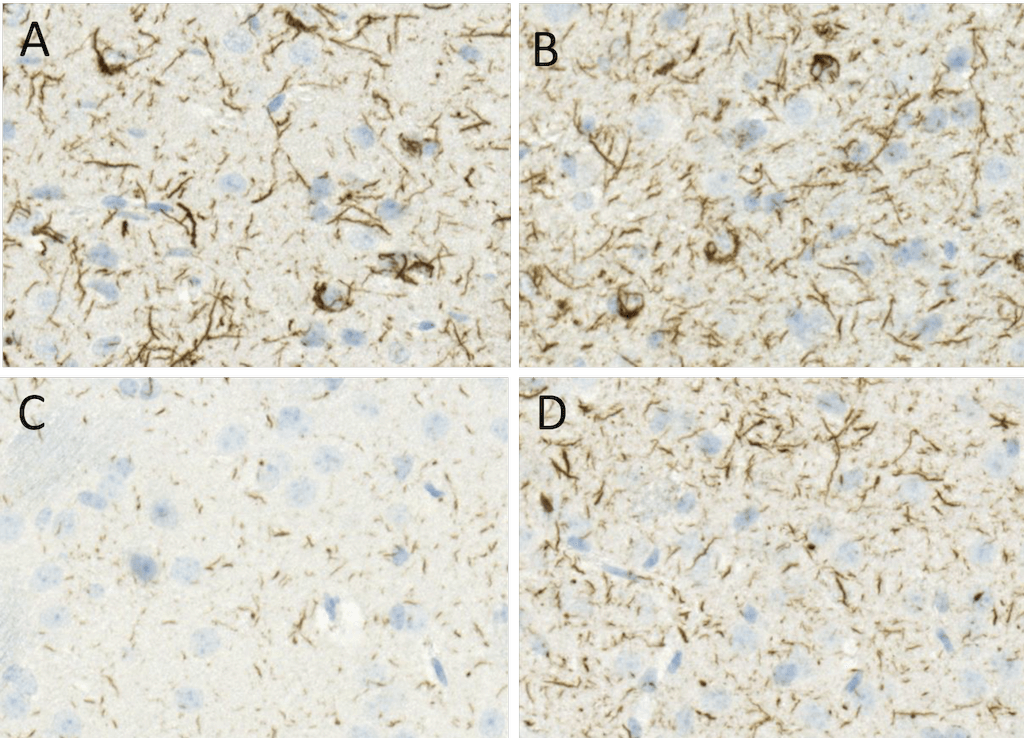
Immunohistochemistry analysis using Rabbit Anti-Alpha Synuclein pSer129 Monoclonal Antibody, Clone J18 (SMC-600). Tissue: Brain. Species: Mouse. Primary Antibody: Rabbit Anti-Alpha Synuclein pSer129 Monoclonal Antibody (SMC-600) at 1:10000. Secondary Antibody: anti-rabbit HRP. C57/BL6 mice were injected with 5 ug sonicated mouse recombinant alpha synuclein PFFs (SPR-324) at 8 weeks of age. Mice were unilaterally injected in the dorsal striatum (bregma AP + 0.2 mm, L +/1 2.0 mm, V – 3.0 mm) and sacrificed 30 days post-injection. (A) contralateral cortex. (B) ipsilateral cortex. (C) contralateral striatum. (D) ipsilateral striatum. Courtesy of: Porsolt.
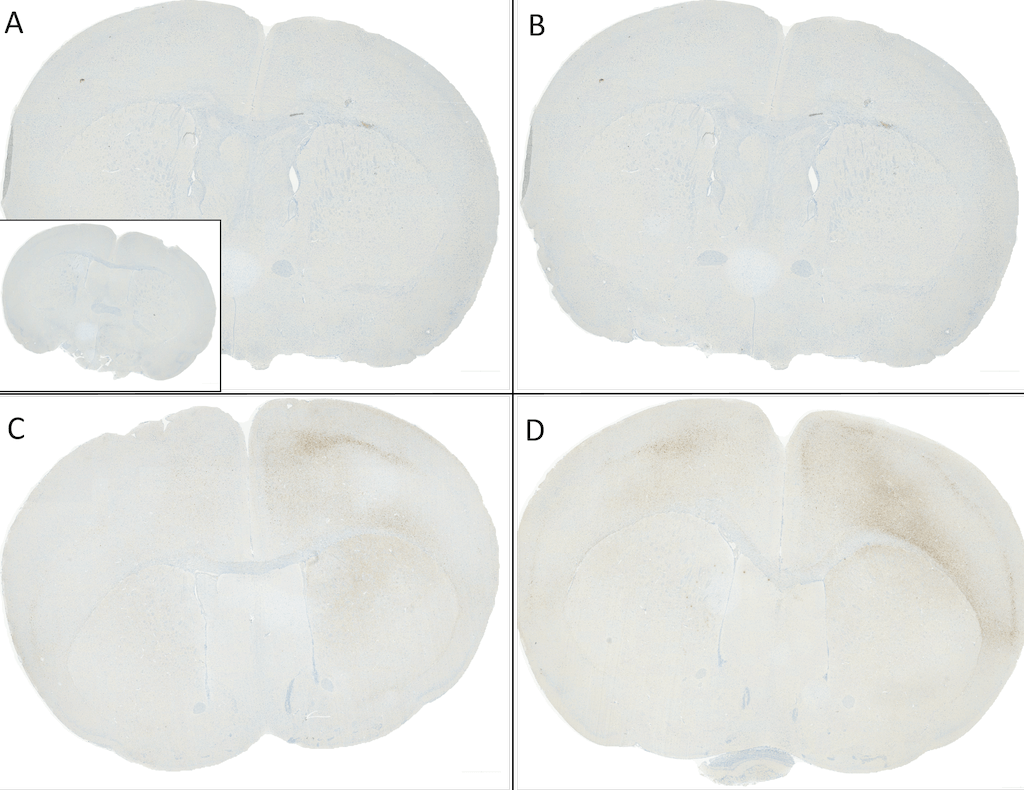
Immunohistochemistry analysis using Rabbit Anti-Alpha Synuclein pSer129 Monoclonal Antibody, Clone J18 (SMC-600). Tissue: Brain. Species: Mouse. Primary Antibody: Rabbit Anti-Alpha Synuclein pSer129 Monoclonal Antibody (SMC-600) at 1:10000. Secondary Antibody: anti-rabbit HRP. C57/BL6 mice were injected with sonicated recombinant mouse alpha synuclein monomers or fibrils at 8 weeks of age. Mice were unilaterally injected in the dorsal striatum (bregma AP + 0.2 mm, L +/1 2.0 mm, V – 3.0 mm) and sacrificed 30 days post-injection. (A) 1.25 uL mouse alpha synuclein monomers (SPR-323). (B) 2.5 uL mouse alpha synuclein monomers (SPR-323). (C) 2.5 ug alpha synuclein PFFs (SPR-324). (D) 5 ug alpha synuclein PFFs (SPR-324). Inset: PBS (negative control). Courtesy of: Porsolt.
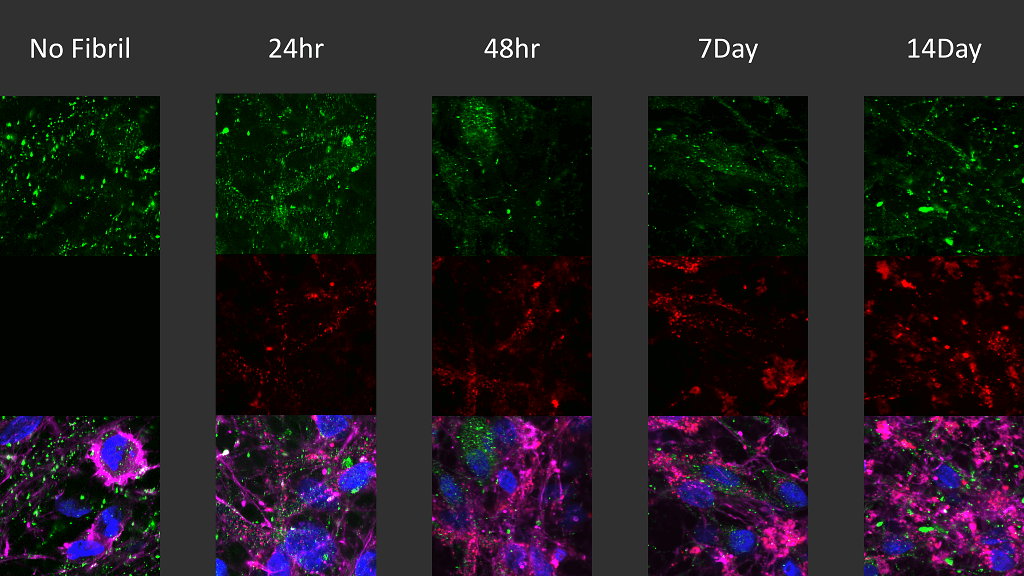
Immunocytochemistry / Immunofluorescence analysis of human iPSC-derived neurons (Stem Cell Catalog Code ASE-9321KF) treated with 2.5µg ATTO 594 labeled type I alpha-synuclein pre-formed fibrils (SPR-322-A594) for up to 14 days. Cells seeded at 8k cells per well. Green: mouse anti-alpha synuclein (pSer129) monoclonal antibody (SMC-600) 1:5000; Red: alpha-synuclein PFFs (SPR-322-A594); Pink: actin; Blue: Hoechst / DNA.
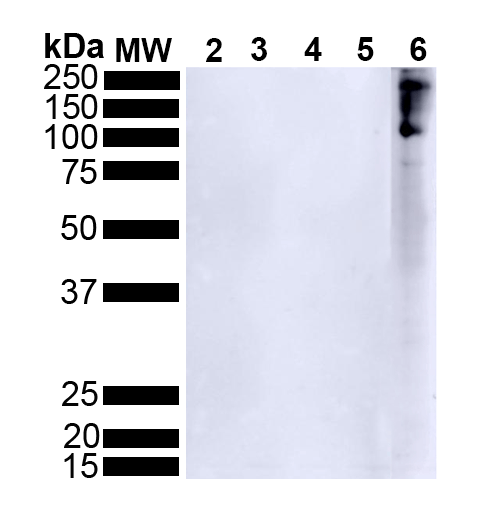
Western Blot analysis of Human Alpha Synuclein showing detection of Alpha Synuclein pSer129 protein using Rabbit Anti-Alpha Synuclein pSer129 Monoclonal Antibody, Clone J18 (SMC-600). Lane 1: MW ladder. Lane 2: 0.5 ug human alpha synuclein monomer (SPR-321). Lane 3: 2 ug human alpha synuclein monomer (SPR-321). Lane 4: 0.5 ug human alpha synuclein PFFs (SPR-322). Lane 5: 2 ug human alpha synuclein PFFs (SPR-322). Lane 6: 15 ug human Parkinson’s Disease brain lysate.. Block: 5% BSA in TBST. Primary Antibody: Rabbit Anti-Alpha Synuclein pSer129 Monoclonal Antibody (SMC-600) at 1:500 for 2 hours at RT with shaking. Secondary Antibody: Goat anti-rabbit IgG:HRP at 1:4000 for 1 hour at RT with shaking. Color Development: Chemiluminescent for HRP (Moss) for 5 min in RT.
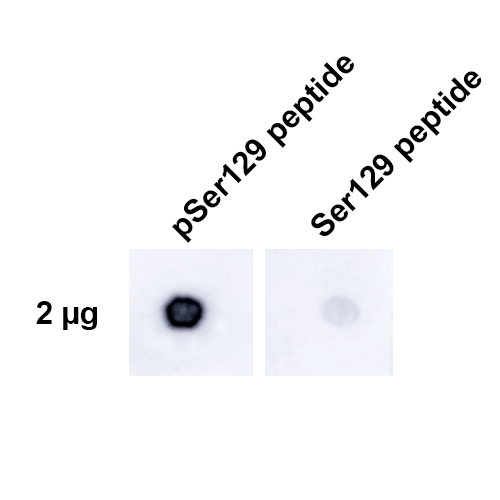
Dot Blot analysis using Rabbit Anti-Alpha Synuclein pSer129 Monoclonal Antibody, Clone J18 (SMC-600). Tissue: alpha synuclein peptide. Primary Antibody: Rabbit Anti-Alpha Synuclein pSer129 Monoclonal Antibody (SMC-600) at 1:500 for 2 hours at RT with shaking . Secondary Antibody: Goat anti-rabbit IgG:HRP at 1:4000 for 1 hour at RT with shaking . Phospho peptide sequence: AYEMP-pS-EEGYQ. Non-phospho peptide sequence: AYEMPSEEGYQ. This sequence is the same for human, mouse, and rat.
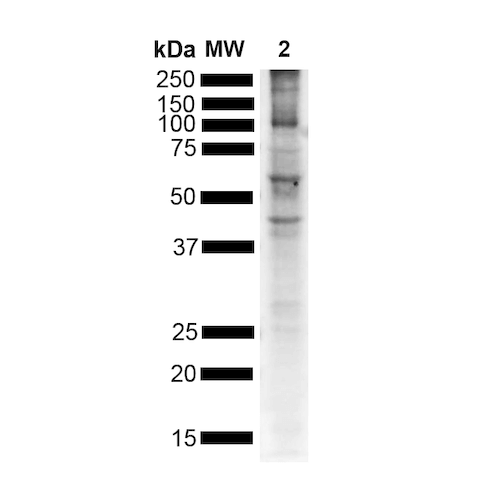
Western Blot analysis of Mouse Brain showing detection of Alpha Synuclein pSer129 protein using Rabbit Anti-Alpha Synuclein pSer129 Monoclonal Antibody, Clone J18 (SMC-600). Lane 1: MW ladder. Lane 2: Mouse brain. Load: 15 ug. Block: 5% BSA in TBST. Primary Antibody: Rabbit Anti-Alpha Synuclein pSer129 Monoclonal Antibody (SMC-600) at 1:500 for 2 hours at RT with shaking. Secondary Antibody: Goat anti-rabbit IgG:HRP at 1:4000 for 1 hour at RT with shaking. Color Development: Chemiluminescent for HRP (Moss) for 5 min in RT.
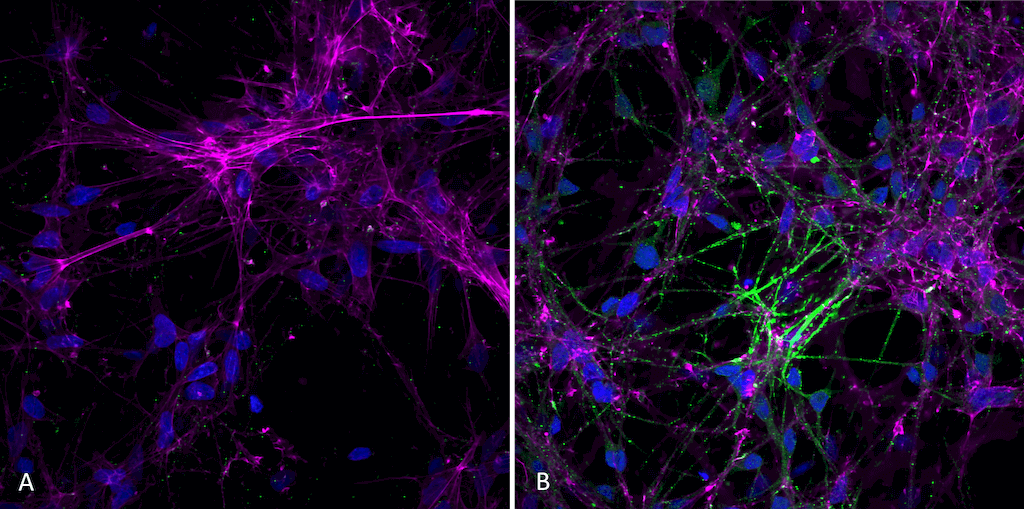
Immunocytochemistry/Immunofluorescence analysis using Rabbit Anti-Alpha Synuclein (pSer129) Monoclonal Antibody, Clone J18 (SMC-600). Tissue: iPSC-derived neurons. Species: Human. Primary Antibody: Rabbit Anti-Alpha Synuclein (pSer129) Monoclonal Antibody (SMC-600) at 1:1000 for O/N at 4°C. Secondary Antibody: Anti-Rabbit: A488 at 1:1000 for 1 hour at RT. Magnification: 40X. Nuclear stain: Hoechst- 20 min, RT (blue). Actin stain: Phalloidin-647- 20 min, RT (magenta). 4K cells per well. iPSC neurons: Applied StemCell Catalog # ASE-9321K. A) negative control; no fibrils added to well. B) 7 days after addition of active recombinant human pre-formed fibrils (Type 1). StressMarq catalog # SPR-322. Sonicated before use, 2.5 ug per well.

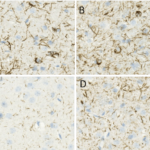
![Rabbit Anti-Alpha Synuclein Antibody (pSer129) [J18] used in Immunocytochemistry/Immunofluorescence (ICC/IF) on Human iPSC-derived neurons (SMC-600)](https://www.stressmarq.com/wp-content/uploads/SMC-600_Alpha-Synuclein-pSer129_Antibody_J18_ICC-IF_Human_iPSC-derived-neurons_1-100x100.png)
![Rabbit Anti-Alpha Synuclein Antibody (pSer129) [J18] used in Dot Blot (DB) on alpha synuclein peptide (SMC-600)](https://www.stressmarq.com/wp-content/uploads/SMC-600_Alpha-Synuclein-pSer129_Antibody_J18_DB_alpha-synuclein-peptide_1-100x100.png)
![Rabbit Anti-Alpha Synuclein Antibody (pSer129) [J18] used in Western Blot (WB) on Human Alpha Synuclein (SMC-600)](https://www.stressmarq.com/wp-content/uploads/SMC-600_Alpha-Synuclein-pSer129_Antibody_J18_WB_Human_Alpha-Synuclein_2-100x100.png)
![Rabbit Anti-Alpha Synuclein Antibody (pSer129) [J18] used in Western Blot (WB) on Mouse Brain (SMC-600)](https://www.stressmarq.com/wp-content/uploads/SMC-600_Alpha-Synuclein-pSer129_Antibody_J18_WB_Mouse_Brain_1-100x100.png)




















StressMarq Biosciences :
Based on validation through cited publications.